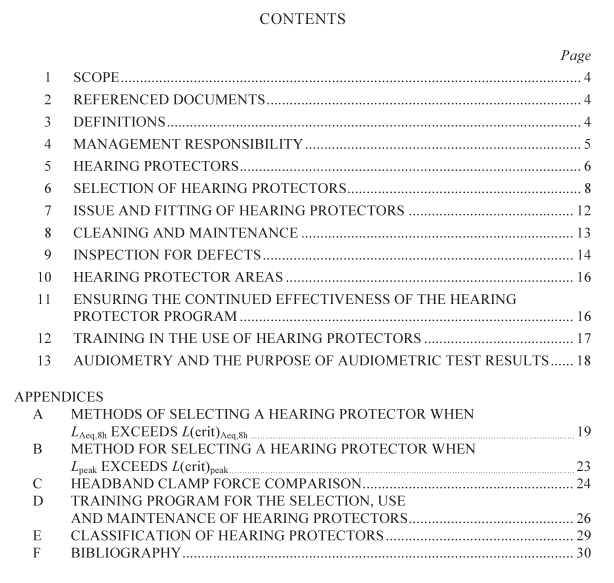AS NZS 1269.3 pdf download – Occupational noise management Part 3: Hearing protector program

AS NZS 1269.3 pdf download – Occupational noise management Part 3: Hearing protector program
3.3 Criterion peak sound pressure level, L(crit) peak The peak sound pressure level above which the provision of hearing protectors is required by legislation or by the organization’s noise policy, whichever is the lower.
3.4 Effective level (of a sound for people wearing hearing protectors) L(eff) A quantity derived by subtracting the attenuation of a hearing protector from the level of the sound in which it is worn. The value of L(eff) is not measured directly, but is calculated by the methods given in Appendix A. NOTES: 1 Because different wearers obtain different attenuation from the same hearing protector, attenuation values are expressed in statistical terms, usually as the attenuation value obtained or exceeded by 80% of wearers. Since it is derived from statistical attenuation values, L(eff) Aeq is also expressed in statistical terms, e.g. as the value of L(eff) Aeq below which 80% of wearers are expected to fall. 2 Analogous to the way the term ‘level’ is further qualified when used to refer to exposure level, immission level, octave-band level, etc., the term ‘effective level’ may be similarly qualified to refer to effective exposure level, effective immission level, effective octave-band level, etc. Accordingly, the symbol L(eff) may be subscripted following the same conventions as those used for subscripting L; thus where L Aeq , Ti stands for partial exposure level, L(eff) Aeq,Ti stands for effective partial exposure level, etc. 3 The value of the quantity L(eff) is not necessarily the same as the value of the A-weighted sound level that may be measured in the ear canal of a person wearing a hearing protector.
3.5 Maintenance The regular inspection and repair of the protector, e.g. the replacement of defective earmuff cushions.
3.6 Over-protection The selection and wearing of a hearing protector with unnecessarily high attenuation. NOTE: This may lead to a sense of isolation and difficulties with perception of sound.
3.7 Selection The process of choosing the most suitable protector.
3.8 Use The day-to-day wearing of a hearing protector by the person to be protected.
4 MANAGEMENT RESPONSIBILITY If the protection from occupational noise requires the use of hearing protectors, the purchase and issue of such equipment forms only part of the overall management responsibility. A comprehensive and properly managed hearing protector program, as outlined in this Clause, shall be implemented. The hearing protector program shall be established by management and an individual shall be designated to manage the program. The person should have a technical and professional background enabling them to make sound decisions based on evaluation and understanding of workplace hazards. The individual should preferably be a safety officer, occupational hygienist, occupational health nurse or physician. In a small company, the program may be managed by the company owner, foreperson or other supervisory personnel. Regardless of who assumes responsibility for the program, the program manager shall have the full support of management. The person shall develop a standard operating procedure. It should be based upon the following:
(a) Documentation showing the reasons why the hearing protectors selected were considered the most suitable.
(b) A training program in which personnel can become familiar with hearing protectors, including selection and proper fitting procedures as well as the proper use and limitations of the equipment.
(c) Provisions for assigning a selected range of suitable hearing protectors to people for their exclusive use.
(d) A record of which type of hearing protector has been issued to each person.
(e) Provisions for adequate supplies of hearing protectors at accessible locations.
(f) Provisions for regular cleaning of the hearing protectors.
(g) Provisions for proper storage of the hearing protectors.
(h) Provisions for periodic inspection and maintenance of the hearing protectors.
(i) Provisions for the identification and marking of areas where hearing protectors must be worn and ensuring that protectors are worn as required.
(j) Continuing education and motivation programs, designed to promote correct wearing of hearing protectors and to maintain a responsible, positive attitude towards hearing preservation.
(k) Ongoing auditing by the program manager to ensure its continued functioning and effectiveness.
(l) Evaluation of each person assigned to wear hearing protectors to determine if he or she is physically suited.
(m) Provision for ongoing auditory assessment if appropriate (see Clause 13).
5 HEARING PROTECTORS
5.1 General
The primary function of a hearing protector is to reduce the amount of noise reaching the inner ear of the wearer. This can be achieved by—
(a) completely covering the entire ear;
(b) covering the entrance to the ear canal;
(c) completely occluding the ear canal itself;
(d) neutralizing the noise through electronic means before it reaches the ear (see Clause 5.2.5(b)); or
(e) covering a large part of the head as well as the outer ear (see Clause 5.2.4).









